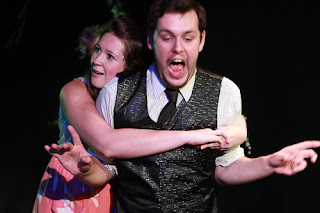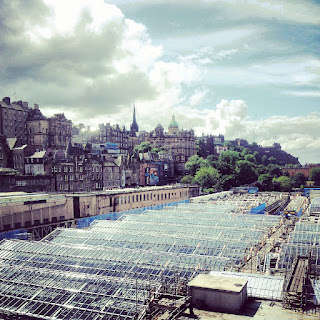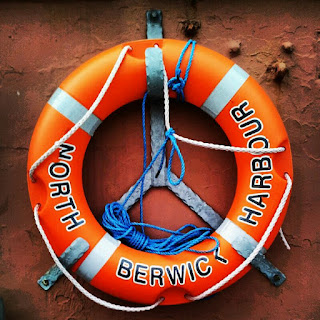Day 83
22nd August 2012
This evening I was asked by Tread The Boards theatre company to photograph their final dress rehearsal, and use some of the images outside of the entrance to let the audience know what they are in for!
I have done this 'job' before, and I always find that it's trial and error to get your good shots. Always juggling ISO, shutter speed and aperture, it's difficult to get right. Especially in the dark of the audience!
Here comes the science. Skip to the pictures if you don't like lectures! Maybe you might learn something!
ISO
The sensor's sensitivity to light, normally runs from 100, 200, 400, 800, 1600, 3200. At 100, the sensor is very sensitive to light, and is perfect for shooting in sunlight/outdoors. At 3200, the sesnsor doesn't really care anymore, it just wants to brighten things up at any cost, so for that reason you lose quality. The darker the scene/lighting, be it natural or illuminous the higher you have to mark your ISO - that is of course providing you don't want to use flash.
Aperture
This is the part of the lens that you pay your money for! Anywhere from wide as f/32 to f/1.2, you can actively tell the lens how much light to let in. This is controlled by the motors inside the lens that open up to the width of your lens, or decrease to the size of a pea - and smaller. A wide aperture, f11 and above, is ideal for landscapes, as then you can really get everything into focus, as well as absorbing those nice colours in the sky. This would be no good indoors though, as there is a mild chance that everything will be dark at that level, which is where you use your low numbers. Also low f stop numbers help you to isolate your subject and get a really sharp focus on one thing.
Shutter Speed
Basically, the blink of an eye. Imagine opening and closing your eye anywhere from 1/4000'th of a second - all the way to 30 seconds, thats how ss basically works. It's the amount of time that the mirror in the camera has to deflect what it sees through the lens, up to the sensor. Faster shutter speeds are great for sport, capturing a surfer on wave for example, freezing the action in time, getting those droplets of water flying around. Long shutter speeds are perfect for night photography, capturing a busy city scene - like London Bridge lit up at night - it doesn't change colour or move (except when the Queen sails through), so you can shoot a long exposure, also water is great for this, as it smooths out the surface.
Flash
Everybody uses flash on cameras, but when is it most effective? Obviously as a substitute for natural or low light. It makes camera believe that there is more light around what you are shooting than there actually is. With DSLR's, Flashguns are a musthave for indoor photography (i actually haven't got one), as the inbuilt flash that pops up isn't great - it's harsh, and always washes out people's faces of any natural skin tone. External flash however, is great because you can change the direction of the flash, bouncing it off hard surfaces that maybe around the subject. Flash can really save the day! I doubt you'd ever see a wedding photographer shooting indoors wihout their flash.
The human eye has all these things in built (apart from flash), I'll give you some for instance's.
When you've been in a really bright outdoorsy type of place, and you have to go in to a room with no windows or the curtains drawn with no light, or vice versa, when your eyes adjust themselves to the available light - this like ISO, sensitivity to light. Or when you wake up, with a rotten hangover. Like that.
When you focus on your finger in front of your nose (closing one eye), your pupil dilates slightly to let more or less light in, and when you move it away further or take it away, your pupils adjust automatically. This like aperture, constantly evaluating what we look at, and what we focus on. We can't focus on everything all the time, no matter how 20/20 you are!
When you close your eyes, and open them for any length of time, that's shutter speed. Imagine that a camera's eye is always closed, and only opens when you take a shot.
That being said, you can tell how many things there are to consider when shooting indoors, without a flash, it's a constsnt balancing act, with change of lighting in theatre, the moving people and their props - here are a few shots of the show.
So if the pictures are blurred, not light enough, too dark, if the quality isn't quite right - you know how to fix it! Get your camera out and go take some pictures!
Tread The Boards 22/8/12
A Midsummer Night's Dream
Saturday, 25 August 2012
Monday, 20 August 2012
Pet Pawtraits!
 After looking out at a beautiful day from the windows at work, I decided that when I get home tonight I will shoot some pet portraits. In theory this sounds easy, but in practise it's quite difficult. I found out that you have to be prepared for sudden movements, stubborn animal behaviour, and not tempting the animal that much to pose, that you are left with a licked all over lens.
After looking out at a beautiful day from the windows at work, I decided that when I get home tonight I will shoot some pet portraits. In theory this sounds easy, but in practise it's quite difficult. I found out that you have to be prepared for sudden movements, stubborn animal behaviour, and not tempting the animal that much to pose, that you are left with a licked all over lens.Just so happens, that Sasha, my dog, is terrible with all these things. To be a wildlife photographer, patience is key, but photographin pets can be more.... Frustrating!
Great fun though. Sasha had me rolling into all different positions, high and low, near and far. I decided to shoot with my prime lens, 50mm, and chose (a) narrow aperture/s between f/1.8 and f/4. Shooting with low aperture numbers enables you to bring out detail, and really isolates your subject to capture something specific, like a facial expression for example (the same rules apply when shooting people really, portraits require background blur for subject isolation, debatably).
Next time I do this, I will give it a whole morning or afternoon, and hope for a sunny day, unless you want to shoot them indoors. Natural light on portraits always looks better, in my opinion anyway...
As you can see from the top picture, not every shot I took was glamorous.
The whole point is, without question, to capture your pet's personality. With a bit of leaping, persuading and imploring, it should be easier said than done. Getting there is the whole fun though!
Photograph your pet tonight, and see how you get on!
Here is mum giving Sasha a brush, and she appears to either not like it, or jeering at me behind the camera.
Here are some of the pics.
You can get a nice natural look, by just pointing the camera, focusing, and waiting for them to look down the barrell of the camera. Unfortunately, Sasha here looks a bit gormless, and uninspired by my direction.

I ran up the garden for this one, and then got into position for her run down to her favourite spot in the garden. A fast shutter speed of 1/1500 made sure I captured her quick movement without any motion blur.
Same again here, shame she wasn't looking the other way!
This was shot landscape, but I tilted it portrait for a more abstract look. I like the shadow and highlight ratio in this one.
Scooby-doo impression.
 This is what I had to deal with for almost 10 minutes. A dog that's more interested on whats the other side of the fence. I tried to go the other side to capture her expression, but was shooting straight into the sun and had a very hazy effect.
This is what I had to deal with for almost 10 minutes. A dog that's more interested on whats the other side of the fence. I tried to go the other side to capture her expression, but was shooting straight into the sun and had a very hazy effect.Once again, unimpressed.
A little more impressed, not much though.
A nice natural indoor shot.
Slightly out of shot was a biscuit that held her to sitting ransom. That didn't last long!

I feel some of these in portrait have potential, requires getting down on your hands and knees though!


Going....
Going.....
Gone.
Daft as a brush.

See what a diva my model was? Try it - hopefully yours will be better behaved!
Friday, 17 August 2012
Edinburgh Fringe 2012
Each year in August, Edinburgh is the Mecca for performers. Celebrating the best (and worst) of theatre, comedy and anything else you could probably put on a stage, this city really has a 24 hour buzz about it.
This year there were about 2,800 performances of various things in styles, from Shakespeare to Sausage eating on stage.
In the spare time that I had off, I managed to take some snaps, some by Instagram, and some with my 600d. Hopefully you can tell the difference.
Here are a selection of shots from the 2 week stay which hopefully encapsualte the feel of the place. Walking down the Royal Mile in March or November I'm sure would be very different. Hopefully these pictures will tell their own story!
During the time that I had there, I managed to climb Arthur's Seat, (the highest point in Edinburgh and also an extinct volcano) and visit North Berwick, a beautiful coastal town about 30 minutes by train from Edinburgh.
If you have never been to the fringe, or even Edinburgh, you must go; it is fairly small city considering it is a capital city, but full of culture and Scottish people!
Edinburgh Castle in the background on the hill, and Edinburgh Waverley station in the fore.
After 5 minutes of being in Ed, this is one of the more 'normal' sights to behold.
Cool church on Princes Street, just off St Andrew's Square. I just call it Thunderbird 3.
I don't know how effective this would be against the freezing, roaring North Sea.
From the foot of the clock tower at Edinburgh Castle.
Just to distinguish, the above were taken from my phone, and edited in Instagram.
Love the lonely figure at the bottom of the alley... Narrow aperture makes it look spooky!




Highest gig at the fringe on Arthur's seat! Watched a comedy gig!
Fishing/lobster baskets in North Berwick


 I asked these lads if they were in a show, and they said no. They should be. I somehow got talking to these two, and they were hilarious. Edinburgh's version of The Flight of The Concords.
I asked these lads if they were in a show, and they said no. They should be. I somehow got talking to these two, and they were hilarious. Edinburgh's version of The Flight of The Concords.
This year there were about 2,800 performances of various things in styles, from Shakespeare to Sausage eating on stage.
In the spare time that I had off, I managed to take some snaps, some by Instagram, and some with my 600d. Hopefully you can tell the difference.
Here are a selection of shots from the 2 week stay which hopefully encapsualte the feel of the place. Walking down the Royal Mile in March or November I'm sure would be very different. Hopefully these pictures will tell their own story!
During the time that I had there, I managed to climb Arthur's Seat, (the highest point in Edinburgh and also an extinct volcano) and visit North Berwick, a beautiful coastal town about 30 minutes by train from Edinburgh.
If you have never been to the fringe, or even Edinburgh, you must go; it is fairly small city considering it is a capital city, but full of culture and Scottish people!
Edinburgh Castle in the background on the hill, and Edinburgh Waverley station in the fore.
After 5 minutes of being in Ed, this is one of the more 'normal' sights to behold.
Cool church on Princes Street, just off St Andrew's Square. I just call it Thunderbird 3.
I don't know how effective this would be against the freezing, roaring North Sea.
From the foot of the clock tower at Edinburgh Castle.
Just to distinguish, the above were taken from my phone, and edited in Instagram.
Love the lonely figure at the bottom of the alley... Narrow aperture makes it look spooky!




Highest gig at the fringe on Arthur's seat! Watched a comedy gig!
Fishing/lobster baskets in North Berwick


 I asked these lads if they were in a show, and they said no. They should be. I somehow got talking to these two, and they were hilarious. Edinburgh's version of The Flight of The Concords.
I asked these lads if they were in a show, and they said no. They should be. I somehow got talking to these two, and they were hilarious. Edinburgh's version of The Flight of The Concords.
North Berwick.
Subscribe to:
Comments (Atom)



























































